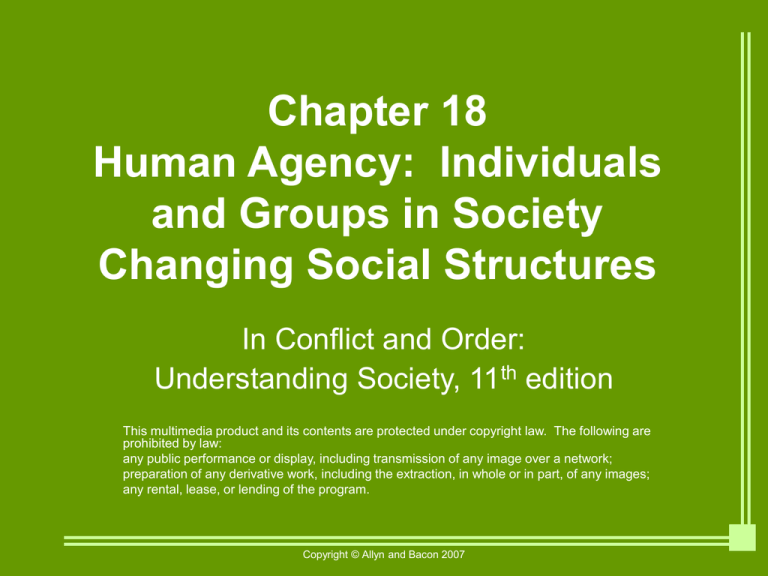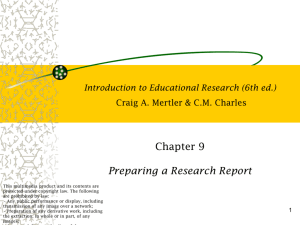Chapter 18 Human Agency: Individuals and Groups in Society
advertisement

Chapter 18 Human Agency: Individuals and Groups in Society Changing Social Structures In Conflict and Order: Understanding Society, 11th edition This multimedia product and its contents are protected under copyright law. The following are prohibited by law: any public performance or display, including transmission of any image over a network; preparation of any derivative work, including the extraction, in whole or in part, of any images; any rental, lease, or lending of the program. Copyright © Allyn and Bacon 2007 The Sociological Paradox: Social Structure and Agency • While society constrains what we do, it does not determine what we do. – Society is not a rigid entity, composed of robots – What people consider sacred, and therefore unchangeable, is a social construction that can be reconstructed – Since social structures are created, they are imperfect, always in need of reform or transformation Copyright © Allyn and Bacon 2007 Social Movements A social movement is a collective attempt to promote or resist change. Copyright © Allyn and Bacon 2007 Social Movements • An ideology is a set of ideas that explains reality, provides guidelines for behavior, and expresses the interests of a group. – It may be elaborate or it may be narrowly aimed at one side or the other. Copyright © Allyn and Bacon 2007 Types of Social Movements • Resistance movements – Explicitly organized movements to either resist change or they are reactionary in that they seek to reverse changes that have already occurred and restore “traditional values” Copyright © Allyn and Bacon 2007 Types of Social Movements • Reform movements – Seek to alter a specific part of society and commonly focus on a single issue – Typically, there is an aggrieved group Copyright © Allyn and Bacon 2007 Types of Social Movements • Revolutionary movements – Seek radical change by going beyond reform to seek to replace the existing social institutions with new ones that conform to a radically different vision of society Copyright © Allyn and Bacon 2007 The Life Course of Social Movements • Social movements move through predictable stages. • First Stage – The movement must attract members. – Usually there is some societal condition that threatens or harms some segment of society. • Second Stage – Grievances become focused and leaders emerge. Copyright © Allyn and Bacon 2007 The Life Course of Social Movements • Third Stage – Resources are mobilized and a formal organizational structure is developed. • Fourth stage – If the movement is successful, it becomes integrated into society. – This is the stage of institutionalization and a common danger is goal displacement. Copyright © Allyn and Bacon 2007 Agency: Social Change from the Bottom Up • The Civil Rights Movement – The civil rights movement did not begin in the 1960s, but rather from the time Blacks arrived here as slaves. – The civil rights movement is not the result of a single event. – It carries the cumulative effects of centuries of mistreatment of Blacks by Whites and White governments. Copyright © Allyn and Bacon 2007 Agency: Social Change from the Bottom Up • The Civil Rights Movement (continued) – The civil rights movement came together in the 1950s, with the passage of the Supreme Court decision desegregating the schools, the outrage of the lynching of Emmitt Till, and the Montgomery bus boycott. – Economic boycotts and sit-ins were organized. – The movement was partially successful, as segregationist laws and practices were soon abolished. Copyright © Allyn and Bacon 2007 Agency: Social Change from the Bottom Up • The Civil Rights Movement (continued) – Racial equality has not yet been achieved, however, as measured by wages, employment opportunities, unemployment rates, poverty rates, desegregated neighborhoods, and differences in money spent on education. Copyright © Allyn and Bacon 2007 Agency: Social Change from the Bottom Up • Gender Equity in Sports – Before 1970, U.S. sport was almost exclusively for men and boys. – However, as a consequence of court cases, individual acts of courage by women pioneers in sport, and the efforts of women’s organizations, dramatic moves toward gender equity in sports have been accomplished. Copyright © Allyn and Bacon 2007 Agency: Social Change from the Bottom Up • Gender Equity in Sports (continued) – Archaic rules by athletic organizations prohibiting girls from competition were overturned. – Legislation, most prominently Title IX, was passed which gave impetus to greater participation by girls and women in school sports. – Full gender equity, however, has not yet been reached. Copyright © Allyn and Bacon 2007 Conclusion • The theme of the last chapter is the importance of human beings in constructing and reconstructing society. • Implications – We do not have to be passive actors who accept society’s institutional imperatives as inevitable. – The personal is political. • Society’s structural arrangements are not inevitable. Copyright © Allyn and Bacon 2007





